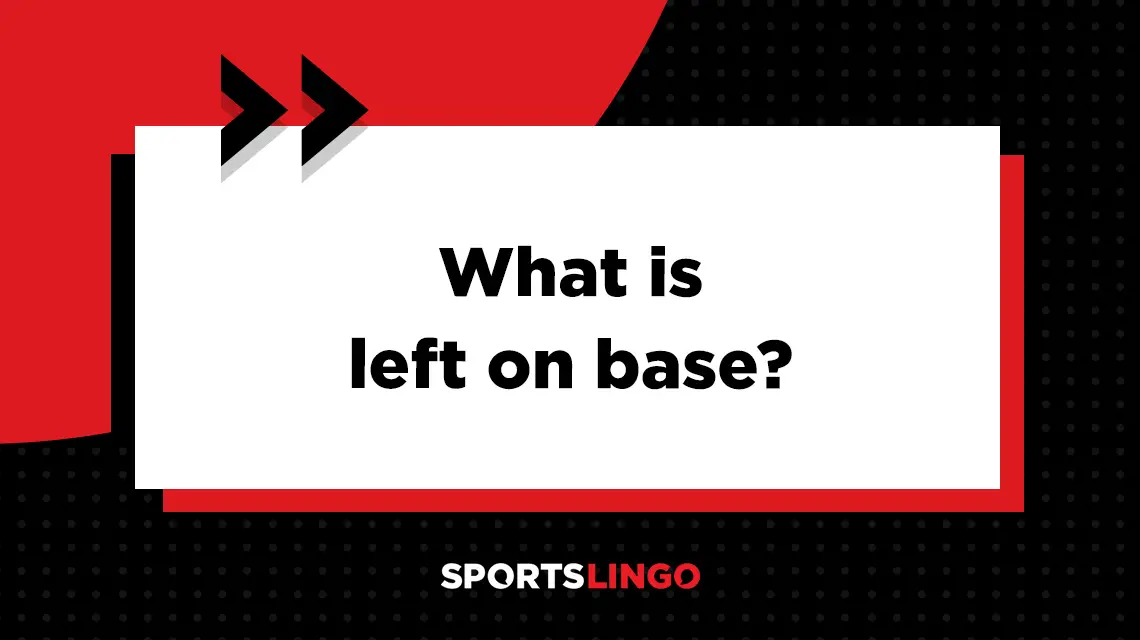
left on base
What is the definition of left on base in baseball?
1. Left on base is a statistic used to measure how many baserunners are still on base at the end of an inning or after a player makes an out during an at-bat.
What does LOB mean in baseball?
LOB is an abbreviation for left on base, which refers to the number of baserunners a team still has on base after a batter is put out at the plate or at the end of an inning.
When a baserunner is still on base as the final out of the half inning occurs, that baserunner is then said to be left on base or stranded. For example, if there are two runners on base after a batter has struck out to end the top of the first inning, then there were two runners left on base recorded for the team.
In addition, if a batter hits into a fielder’s choice and a baserunner is tagged or forced out for the final out, that runner is still considered left on base.
This statistic is usually recorded as a team stat in the final box score, but it can also be recorded as an individual player statistic. When counted for a specific player, LOB reflects how many baserunners the batter has left on base after they’ve recorded an out at the plate.
What is the definition of LOB?
The LOB baseball stat can be an individual player statistic or a team statistic:
- A player’s LOB refers to the number of runners who are still on base when a hitter records a strikeout at home plate or is put out on a hit.
- A team’s LOB refers to the number of runners who are still on base at the time of the third and final out of a half-inning when they are at bat.
Player LOB is usually recorded for single games, while team LOB is typically recorded for games as well as full seasons.
Is a LOB a hit in baseball?
Left on base runners may be counted when a player makes a hit. If the batter hits into a fielder’s choice which ends in a runner being tagged or put out for the third and final out of a half-inning, the runner is still considered to be LOB.
However, runners can also be LOB even if there are no hits. For example, if a batter advances to first base on a walk or hit by pitch (HBP) but is unable to score before the end of an inning, they are counted as a runner LOB. If a runner is able to advance to an extra base without getting caught stealing but doesn’t score a run, they are also counted as LOB in baseball.
Is a high LOB good in baseball?
For players, a high LOB indicates that they were not successful at bringing runners in to score when at bat. Because LOB for players is recorded whenever they make an out at the plate, it also shows a failure to put themselves in a position to score.
For teams, a high number of runners left on base means that they missed out on more potential scoring opportunities compared to teams with fewer runners left on base. Teams generally average about six to seven runners LOB per game.
However, this statistic can be misleading because teams with low LOB don’t necessarily win more games. Team with talented hitters are more likely to have players on base often, which increases their scoring chances. Meanwhile, those with weaker hitters aren’t as likely to get players on base, which means they’re also less likely to score.
Which player has the most runners left on base in a game?
Ryan Zimmerman holds the Major league Baseball (MLB) record for the most runners left on base. On May 8, 2016, Zimmerman left 14 runners on base while playing for the Washington Nationals. The game lasted 13 innings, and the Nationals ultimately lost to the Chicago Cubs with a final score of 4-3. The second-place spot is held by Boston Red Sox player Dustin Pedroia, who had 13 runners LOB over 15 innings on September 15, 2017 in a 13-6 win over the Tampa Bay Rays.
In a regular nine-inning game, the highest total number of runners left on base by an individual player is 12. On September 16, 1972, Glenn Beckert had 12 runners LOB while playing for the Cubs, who went on to beat the New York Mets 18-5. That same number of runners left on base was matched by Colorado Rockies first baseman Todd Helton on April 11, 1998. The Rockies ultimately lost the game 12-5 to the Cincinnati Reds.
Which MLB team has the most runners left on base in a game?
The most runners left on base by a team in a single game is 27. On May 4, 1973, the Atlanta Braves recorded this many runners LOB in a 20-inning game against the Philadelphia Phillies.
For a nine-inning game, the MLB team record for the most runners LOB is held by the New York Yankees. In a matchup against the Boston Red Sox on September 21, 1956, the Yankees had a total of 20 runners left on base. They lost the game 13-7.
Which two MLB teams has the most combined runners left on base in a game?
Looking at the combined totals for two teams, the most runners LOB in a game is 45. This first happened when the St. Louis Cardinals (20 LOB) and New York Mets (25 LOB) played a 25-inning game on September 11, 1974. The record of 45 runners LOB when combining the totals for both teams was matched on June 6, 1991 in an 18-inning game between the Kansas City Royals (25 LOB) and Texas Rangers (20 LOB).
The record number of runners LOB in a nine-inning game is 30. As of the 2022 season, this has happened three times in MLB history:
- August 27, 1935: New York Yankees vs. Chicago White Sox
- July 21, 1961: Washington Senators vs. Los Angeles Angels
- July 8, 2018: Miami Marlins vs. Washington Nationals
Which MLB team has the most runners left on base in a season?
The team with the highest number of baserunners left on base in a single season is the 1941 St. Louis Browns. That year, the team’s total number of runners LOB was 1,334. They finished the season in sixth place in the American League.
Which MLB team has the fewest runners left on base in a season?
The 1957 Kansas City Athletics had the fewest runners left on base in a single season with only 925. It was only the team’s third season in Kansas City, and the team went on to place seventh in the American League.
In 2016, the San Diego Padres had the lowest per-game LOB with 5.96. That season, they had a total of 965 runners LOB with 68 wins and 94 losses.

Gary A. Vasquez/USA TODAY Sports
What does LOB% stand for?
LOB% stands for left on base percentage, which is also referred to as strand rate. This metric is calculated by diving the number of runners on base at the end of an inning by the total number of baserunners allowed. It takes into account how many hits, walks and runs are recorded. This can be expressed with the following formula:
LOB% = (H+BB+HBP-R)/(H+BB+HBP-(1.4*HR))
What does LOB% mean about a pitcher?
LOB% is a pitching statistic used to measure the percentage of baserunners that a pitcher strands on base in a single game or over the course of a season. Pitchers want to have a higher LOB% because it indicates that they are preventing runs from being scored.
What is the most common LOB%?
The league average for LOB% usually hovers around 70%. If a pitcher’s LOB% drops lower, they are allowing more runners on base to score. If their LOB% goes higher, it means fewer runners on base are able to score. Pitchers with a high number of strikeouts often have a higher LOB%.
What other baseball statistics are related to LOB%?
LOB% is one of many statistics which are used to evaluate a pitcher’s performance. Some other key baseball statistics which are related to LOB% include ERA, BABIP and HR/FB.
ERA
Earned run average (ERA) is a baseball statistic that represents the average number of earned runs given up by a pitcher per nine innings pitched. Any runs for which a pitcher can be held fully responsible count as earned runs. A low ERA is one of the factors which indicate a good pitcher.
Adjusted earned run average (ERA+) is a version of this statistic which is scaled to reflect external factors, such as the league ERA average and whether a pitcher is playing in their home ballpark.
BABIP
Batting average on balls in play (BABIP) measures how frequently a batted ball results in a hit, excluding home runs. Both pitchers and batters are evaluated using this statistic, with pitchers aiming to have a low BABIP.
HR/FB
Home-run-to-fly-ball (HR/FB) rate is a statistic showing how frequently home runs are allowed by a pitcher in comparison to the number of fly balls allowed. To calculate HR/FB, the number of home runs is divided by the number of fly balls.
Examples of how left on base is used in commentary
1. With the bases loaded, the Chicago White Sox hit into a 3-6-3 double play for the Detroit Tigers, ending the inning with three left on base.
2. The Philadelphia Phillies drop the game 3-2 to the Los Angeles Dodgers, with five runners left on base for the night, ending their chance at advancement to the World Series.
SportsLingo goes the extra-inch with the meaning of left on base
Although the statistic left on base, or LOB, measures the number of players who were left stranded on any base, many statisticians or fans mainly pay attention to a more specific stat: left on base in scoring position. This statistic only measures those players who were left on base that were on second base and/or third base.
To take it a step further, some people also look at the stat left on base in scoring position with less than two outs. These variations of LOB more accurately reflect a team’s number of missed scoring opportunities.
Sports the term is used
1. Baseball
2. Softball
Also known as:
1. Stranded
Abbreviated as:
1. LOB